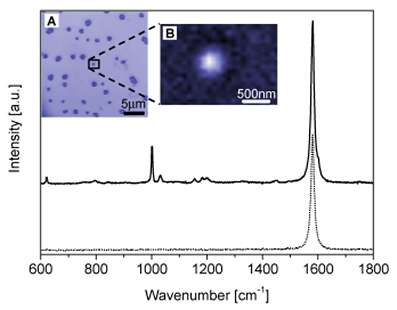Optical Properties of Nanostructured materials
 Nanolens
Nanolens
The
Raman scattering signal of a substrate is investigated
using a polystyrene nanolens of a few hundreds of nanometers
inserted within the light path of a confocal microspectrometer.
As observed in solid immersion microscopy, the nanolens
is at the origin of the improvement of the spatial resolution.
Furthermore, enhancement of the Raman scattering signal
of the substrate is observed when measuring through
the polystyrene bead. The enhancement factors have been
measured for silicon, highly ordered pyrolytic graphite
and gallium arsenide substrates. This set-up provides
a new way of enhancing the Raman signal by means of
the use of nanolens. [ref
30]

Raman
spectra recorded on the HOPG surface near a polystyrene
bead (dotted line) and recorded through the polystyrene
bead (continuous line). The focusing distance is the
same in both measurements. (A) Video image of polystyrene
beads (465nm diameter) deposited on an HOPG surface.
(B) Raman image obtained by integrating the G line (at
about 1600cm-1)of HOPG in a region of 2 x
2.5 µm² around a polystyrene bead.
 Nanotubular crystals and Non-Linear Optical properties
Nanotubular crystals and Non-Linear Optical properties
 Under construction...
Under construction...